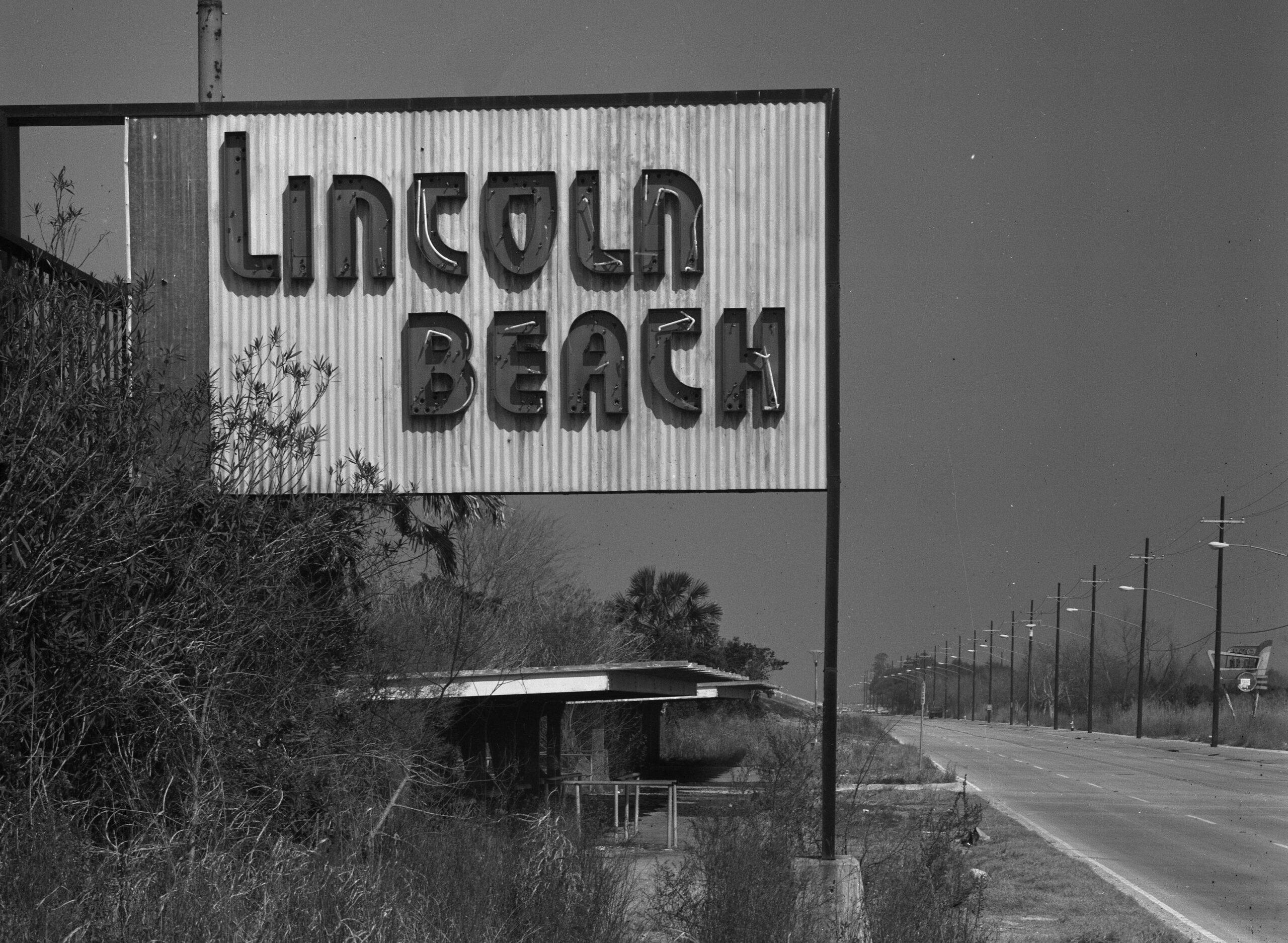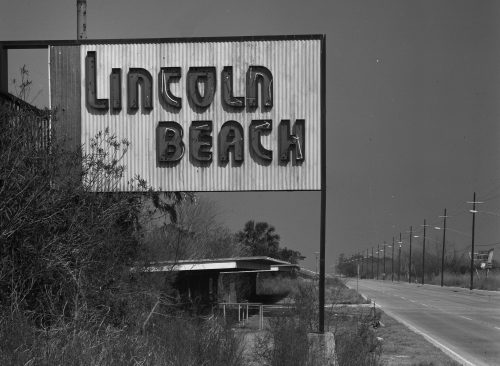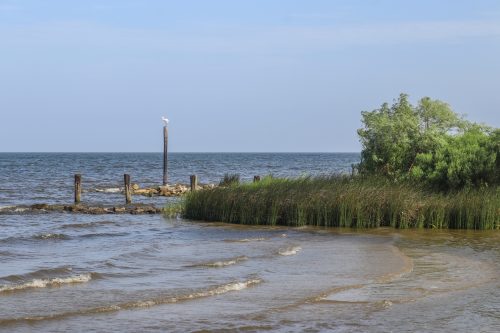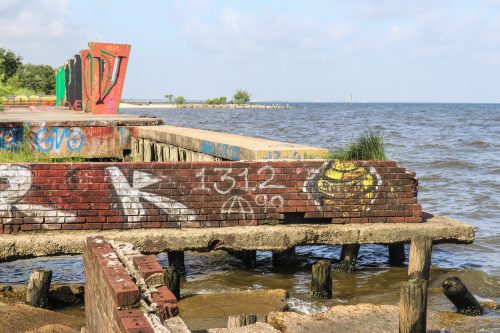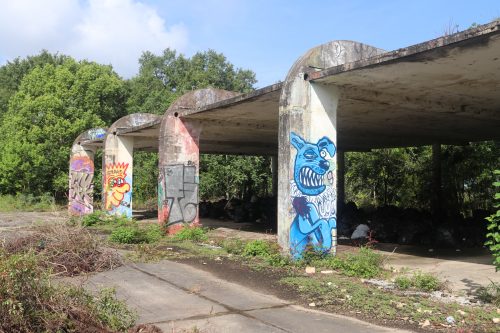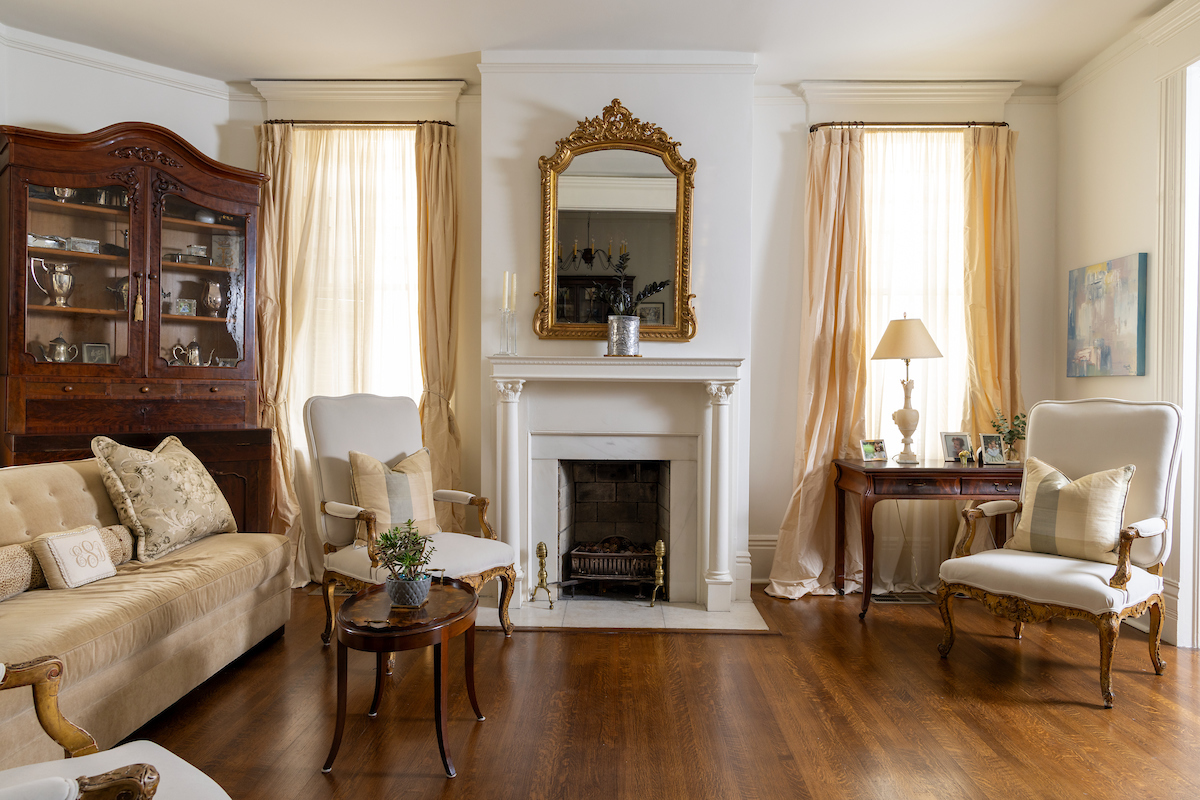This story appeared in the September issue of PRC’s Preservation in Print magazine. Interested in getting more preservation stories like this delivered to your door nine times a year? Become a member of the PRC for a subscription!
New Hope for Lincoln Beach
As desegregation became law, Lincoln Beach, a once joyous and safe place for Black families during the oppression of Jim Crow, was shut down and abandoned by the city. For more than 50 years, the waterfront park was left to the elements.
The pools, where a generation of New Orleanians learned to swim, slowly crumbled into the lakeshore, battered by storms, and weeds and wildlife crept over the park pavilions.
Over the decades since, several proposals to restore Lincoln Beach have come and gone. Some were heralded with much fanfare. But all resulted in little more than dusty media coverage found in newspaper archives.
This summer, though, there’s been a convergence of separate efforts to bring back the beach, with city officials in the midst of technical surveys of the property to assess its condition and to determine the cost of restoration, and a passionate community initiative bent on reopening the property and frustrated by the long abandonment of a space they feel should be revered for its history and its environment.
Advertisement
A group of volunteers called New Orleans for Lincoln Beach has been cleaning up the site without city permission, collecting more than 300 contractor bags full of litter. Though they were trespassing, co-founder Michael “Sage Michael” Pellet said the volunteers just couldn’t stand to see the area trashed. “We’re not trying to alienate the city, but we want to hold them accountable,” he said.
This summer, New Orleans for Lincoln Beach received its 501©3 nonprofit status, and its private Facebook page, which was created in June, has nearly 7,000 members.
Meanwhile, in May, Mayor LaToya Cantrell launched a comprehensive assessment to “determine the kind of mitigation activities that would be necessary to clean the beach up and return it to public use,” according to a statement on the city’s website.
City officials are conducting environmental, structural, topographic and bathymetric (underwater) surveys of the site, examining multiple issues, including:
- the condition of Lincoln Beach’s shelters, tunnels, swimming pool, concrete pads, parking lots and other historic structures
- the current pedestrian, bicycle, vehicular and public transit access possibilities
- the existing drainage, sewerage, water, gas and electrical systems
- the depth of the water off the beach and “the location of underwater debris” that could pose challenges for swimming
- the “suitability of the existing beach for recreational use.”
Photo 1: A sign at the entrance of Lincoln Beach in New Orleans East circa 1970. Photograph by Michael P. Smith, The Historic New Orleans Collection, Acc. No. 2007.0103.1.149. Photo 2: Lincoln Beach today. Photo by Liz Jurey.
City officials recognize Lincoln Beach’s historic importance. It was built during the Jim Crow era to provide a spot for Black families who were prohibited — often violently — from swimming in other parts of the lake and forbidden from enjoying the more lavishly equipped, whites-only Pontchartrain Beach amusement park. (After Pontchartrain Beach desegregated in 1964, the city shuttered Lincoln Beach.)
If Lincoln Beach can be reopened, city officials hope to pay tribute to that history and salvage as much of the original architecture as possible. There have been discussions about nominating the site to the National Register of Historic Places.
The first step, though, is to determine from the survey results what can feasibly be restored, said Department of Public Works Environmental Affairs Administrator Cheryn Robles. She points out that years of destruction — from theft, vandalism, storms and neglect — have taken a toll.
“Several years ago, people broke in to steal all the copper wiring and electrical, and they threw all the transistors into the swimming pool,” causing major damage, said Robles, who is working on the site assessment.
The possibility of reopening Lincoln Beach comes with many challenges, not the least of which is bringing it into compliance with the Americans with Disabilities Act, which passed many years after the park was constructed. The entrance to Lincoln Beach is a tunnel under an active railroad. The tunnel floods when it rains, and the low-lying area has become home to alligators and snakes. The walkway leading up from the tunnel is steep, and could be challenging for those using a wheelchair.
The site sits outside of the levee protection system, so city officials have been coordinating their efforts with the Norfolk Southern Railroad, which owns the railroad above the tunnel, and the Southeast Louisiana Flood Protection Authority.
How the city would pay to revitalize Lincoln Beach also is a question without a specific answer right now. The administration intends “to explore a number of different public and private funding sources” after the site assessment provides “rough estimates” for the restoration cost, according to the city’s website.
Relics of the old swimming pool and park pavillions remain on the site of Lincoln Beach.
New Orleans District E City Councilperson Cyndi Nguyen, who represents New Orleans East, has thrown her support behind the project. “It’s been long overdue to have an investment in Lincoln Beach,” she said. “I know that people are very eager and disappointed that Lincoln Beach has been abandoned for over 50 years. I can’t undo what happened, but as councilperson, and along with the mayor, we are looking at how to do it right.”
Nguyen and the Mayor’s office both point to the potential economic impact that could come from the park reopening. “I envision Lincoln Beach as a place that the City of New Orleans could promote as a family fun day in the East,” Nguyen said. “It could serve as a major catalyst to revitalize the East, bringing opportunities for small business owners, so they can have a piece of the pie. …When communities are involved, and they have an investment, projects like this can be very sustainable.”
While the current water quality survey isn’t complete, the area has shown in earlier testing to be safe for swimming, said Kristi Trail, executive director of the Pontchartrain Conservancy, the nonprofit formerly known as the Lake Pontchartrain Basin Foundation. From 2001 to 2005, the organization analyzed water samples from around the site as well as in other areas of the lake. “Lincoln Beach was the benchmark,” she said. The water quality there proved to be “one of the cleanest sites.”
The Pontchartrain Conservancy hasn’t resumed sampling at Lincoln Beach since Hurricane Katrina, though. “There’s lots of wildlife out there and poison ivy, and we haven’t considered it safe,” said Trail, adding that the organization samples areas where the public is entering the water. “We’re not going by boat, and access at Lincoln Beach by foot is very limited.”
As for exploring the feasibility of reopening Lincoln Beach to the public, Trail said she’s “excited the city is taking this on,” as the area could offer environmental and educational opportunities, as well as access for residents to enjoy the water.
Advertisement
While earlier generations enjoyed swimming in the lake, many current residents have little to no interaction with one of the city’s defining characteristics. Over the past several decades, the lake has essentially been off limits to anyone who doesn’t have a boat, as shoreside opportunities for swimming are very limited. As a result, residents may not fully understand or appreciate its role as an estuary.
“We have demonized all waterbodies,” Trail said. “Katrina came, and the water rose, and people were like, ‘We don’t like water.’ We put up walls to keep the water away.”
Having a place for people to enjoy the lake led to the formation of the New Orleans for Lincoln Beach group. The organization wants to honor the site’s history and to take care of the natural environment around it, said Pellet, who co-founded the group with Tricia Wallace. On its Facebook page, the group’s administrator recently asked: “In your own words, please share why Lincoln Beach is important to you and the community,” and several people posted heartfelt comments.
“Lincoln Beach is an important legacy of our history and has become a story of diversity and unity across cultural lines,” Butchie Beverly wrote on the Facebook page. “It is an ecological gem, one of the few (places to) access the waters that surround us. It has been and continues to be an economical gathering space for family recreation and community. It has great potential to serve as true economic development and commerce through entrepreneurship and an incubator for young small businesses. The revitalization and reopening of the beach to the public is an exercise in empowering the citizenry to require government act upon the will, vision and values they wish their communities to reflect.”
Pellet echoes that sentiment, stressing that New Orleans for Lincoln Beach wants to ensure the community has a voice in any redevelopment plans. He hopes to meet with the mayor. “We have a piece of land dedicated for Black people but celebrated by all people,” he said. “We want our representatives to recognize this organization.”
A professional barber whose work has been disrupted by the COVID 19 pandemic, Pellet was drawn to Lincoln Beach to seek peace after the killing of Ahmaud Arbery, the unarmed African-American man who was fatally shot while jogging in Georgia. Lake Pontchartrain’s raw beauty was a solace, he said. “It’s a natural draw for people to want to be by the water.”
While cautioning against breaking the law and stressing the liability of entering the overgrown park — where the city has removed three alligators from the often-flooded tunnel entrance — Nguyen said she respects the New Orleans for Lincoln Beach group, and recognizes that “they have invested time and resources into cleaning it up.” Once the assessment work is complete, Nguyen plans to hold community meetings to gather public input. “Everyone has a seat at the table.”
Pellet, too, acknowledges the dangers of venturing into Lincoln Beach. “We do not encourage any of our supporters to trespass,” he wrote on the group’s private Facebook page on July 24. “We cannot be liable for your safety. No emergency services have access to the site because of a tunnel entrance in need of major repair or abandoned. … These things take study and time.”
Meanwhile, the city continues its work on the site assessment. Results should be complete by early 2021, Robles said, adding that she shares the community’s hope for a revitalized Lincoln Beach.
“When people see this place for the first time, they are shocked,” she said. “You walk out on the beach, and you don’t even realize you’re in New Orleans. It could be a Caribbean island. It’s just so beautiful.”
Susan Langenhennig is PRC’s Director of Communications and the editor of Preservation in Print.
Read more:
Lincoln Beach was a haven for Black families during oppressive Jim Crow era
New Orleans residents remember Lincoln Beach
Advertisements



